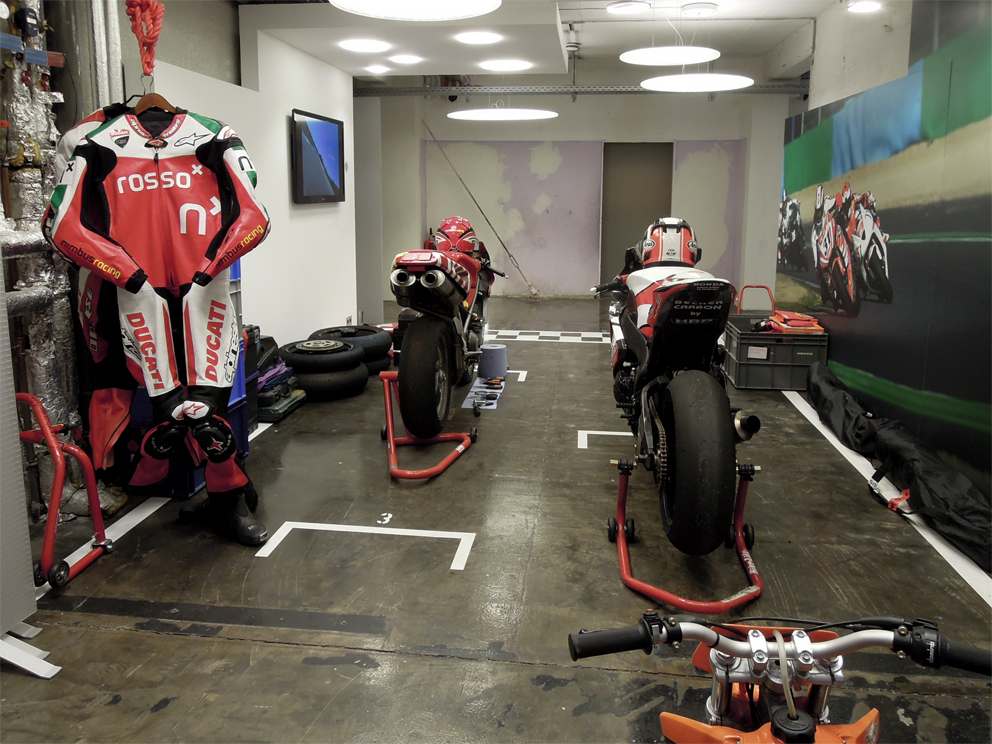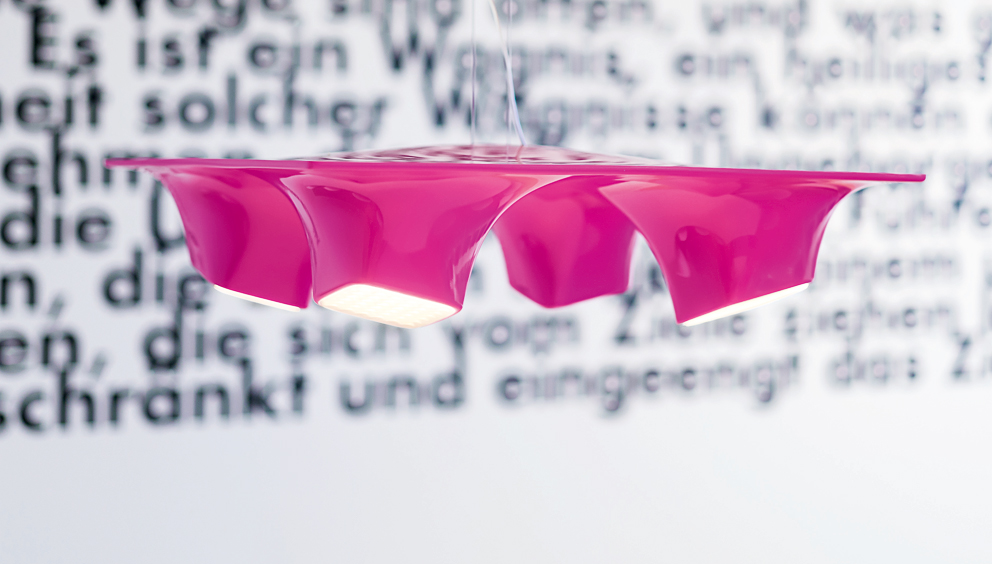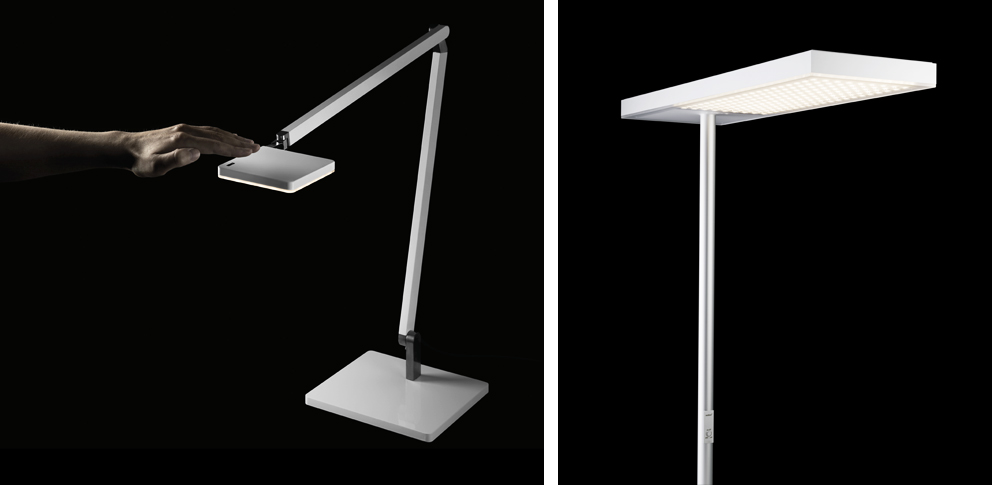Feb 23, 2014

What more do you need: An innovative company, a charismatic CEO and cool products that are pared down to the absolute essentials and state-of-the-art technology. The very name of the luminaire manufacturers has a great ring to it: Nimbus! After all, the Latin word does not refer to any old form of light, but to a very specific one. In almost all cultures saints are depicted in art – and this is in the days before LEDs – and their heads or bodies often shrouded with a halo or aureole of light. Which expresses that the respective person is “enlightened”.
I have according expectations. Especially as company founder, owner and Managing Director Dietrich F. Brennenstuhl likewise has a very special reputation. And he immediately does justice to it – an ingenious lighting specialist who trained as a toolmaker before going on to study construction engineering and then architecture. When he picked me up at reception he was accompanied by a mechanic who had arrived to collect one of Brennenstuhl’s racing Ducatis, which along with two other racing bikes stand in the midst of all the Nimbus luminaires in the company’s “Mock-Up” grid, as if the starting gun were about to sound. “Wanna hear what they sound like,” he says, his passion for racing lighting up his eyes. He hits the throttle and the Ducati briefly revs and roars. Perhaps, I find myself thinking, we should simply talk about motorbikes, and about the goose bumps that spread all over when hearing their sound along with that typical smell of petrol and burned rubber. But the racing Ducati is taken away. And Dietrich F. Brennenstuhl takes me on a tour. Our conversation begins.
Thomas Wagner: Mr. Brennenstuhl, Nimbus not only provides lighting solutions for office buildings, but also for private residences. If we take your “Roxxane” luminaire – is it the regulations for office luminaires that led to your offering a version for homes and one for the office?
Dietrich F. Brennenstuhl: We consciously went for two different versions, and it has nothing to do with the regulations. The office luminaire does not meet the workplace guideline and delivers 500 Lux across a surface of one by two meters. If it were to, it would render our large standard lamp “Office Air LED” absurd. There’s another standard, introduced by a vocational insurance association, according to which the luminaire provides the right degree of light. We simply saw that the small lamp of 7.5 Watt is a marvelous way of providing good reading light. But that isn’t enough for a workstation. So it seemed obvious to develop a second luminaire with 2.5 times the output. Moreover, this allowed for the beautiful formal shift from the small square lamp to the elegant, asymmetric flat lamp. Since we want to sell to both segments anyway offering two luminaires seemed the obvious choice.
So the light output of the particular luminaires you create isn’t solely a matter of norms and regulations?
Brennenstuhl: No, essentially not. With standard lamps for the workplace we of course heed the regulations. But in the case of “Roxxane” we didn’t start from a set brief. And once you’ve embarked on such a product development it simply takes on a life of its own. And then you make a standard lamp, offer the table lamp with a base and various adaptation modes, such as a table-top clamp or an anchoring for USM Haller tops.
A question on the design: You say that each week you are sent proposals by designers. Do you personally sift through them all?
Brennenstuhl: Not any longer. We have a development section. Anything proposals we receive land on the desks there and a selection is then made of the designs we could try and take further.
If I am right you started out designing all your products “in-house”. Since then you’ve also developed luminaires with outside designers, such as Karim Rashid. I must confess that the choice surprised me. Nimbus and Karim Rashid, to my mind those are two different worlds, at least at first sight.
Brennenstuhl: You’re not the only one.
What designers have you worked with to date? Who else would you like to work with? And what designers really grab you, not just as regards luminaires?
Brennenstuhl: You just put it rather sweetly saying that initially we designed all our products “in-house”. I would say that for 25 years we did everything in-house, and only over the last two years have we opted to collaborate with the outside world. These basically chance ventures also arose because our development section was working full tilt to cope with the extensive LED product portfolio we have established in recent years. In such a situation you can almost talk of a kind of “creativity bottleneck”. Which in turn makes you more willing to develop a product with external designers. I’m still very critical when it comes to such projects but the way things went with the “Roxxane” table lamp was simply a great fit.

And Karim Rashid? How did that come about?
Brennenstuhl: Karim Rashid had likewise approached us and wanted to work with us. That is also because we were the first mover in the LED section and evidently did something really well. Which attracted someone like Karim Rashid, precisely because we approached the topic of “light” so puristically. Rashid sent countless sketches, each time structuring the design around our basic elements. He took as his starting point a Nimbus “Modul Q36” in a somewhat smaller form, and I found it all very exciting, as it still shows how the design arose and the synergies he exploited. As regards the aesthetics of “Squeeze”, to be honest I fully concur with you: Karim Rashid is essentially the pure opposite of the mainstream Nimbus designs, and that’s exactly what I found so cheeky and exciting. We indulged ourselves for once! And it was great how different the responses at the fair then were. Some found the luminaire really awful and didn’t understand it one tiny bit. Others said: “Great, at long last you’ve gone for a free form, brought color into play.” What’s certain is that the luminaire really divides opinion. But as I said, that was the idea behind trying it out.
In what segments will “Squeeze” mainly get used?
Brennenstuhl: Primarily in the private domain, for example in homes over dining tables or in restaurants or clubs.


With “Squeeze” Karim Rachid not only harked back to the 1960s and 1970s, and designed a single luminaire. He also developed a modular system that enables you to do quite a lot with interiors. Is that well received?
Brennenstuhl: Things like that take time. It’s a while before the market accepts such a product and retailers grasp the potential it offers and present it accordingly. You first have to win over the retailers. Retail staff have to like a product and risk budgeting with it. Once that happens even an extravagant product can be a success.
Do you feel that LED technology per se spawns a certain design purism, a no-frills vocabulary?
Brennenstuhl: I would say that such an approach seems obvious. For us, a reduced formal idiom was a good chance to first familiarize ourselves with the terrain. In actual fact, LEDs mark a paradigm shift in lighting technology through which we really had to force ourselves, as the development and design approach is completely different. If you simply want to leave out everything that is not essential and focus only on what a luminaire requires, then LED technology is evidently the choice. This was how, for example, we invented the countersunk mechanism, since patented, the acrylic glass element as a diffuse light medium which we also insisted should not be too diffuse as that would lower the light output too greatly. We took as our motto: The system must be as efficient as possible, in line with the basic assumption underlying LED technology. And we then drilled holes in the acrylic glass element and at some point decided: One hole alone is too little, let’s make a countersunk unit out of it, and then we’ll manage to direct the light somewhat and optimize the light output. It all added up to a clear, unequivocal statement: Eliminate whatever possible. Now that was fun, especially when we saw the results. Which is why we have adhered to it ever since, whereby we are permanently improving the countersunk unit.
So your method is a matter of “form follows function” ...
Brennenstuhl: Yes.
... and the new technology opens up new opportunities for design because no lamp socket or mount is required, changing the height of the luminaires and much else besides?
Brennenstuhl: Precisely.

Did you actually start out with LEDs or first produce conventional luminaires?
Brennenstuhl: As a technology, LEDs were invented in the early 1960s. And I must say that they first became accepted in the market as general illumination thanks to our efforts. Before us there were some firms that experimented with LEDs, such as Ingo Maurer. But, as always, he leads the way experimentally, but no light was developed. I always find Ingo Maurer’s designs beautiful. At the same time, it is nonsensical to make something that seems poetic, radiates light somehow, and costs a lot of money. Then you could just as well make a sculpture, not a luminaire. Others simply presented the naked light source, something I do find rather trivial. But to return to your question. Of course we spent those 20 years doing something else, too. We also embarked on conventional lamps and experimented with halogen lamps on suspended wire systems, quite classic at the time. In other words, we deployed a whole range of conventional lamps, even those ghastly energy-saving bulbs that no one wanted from the very outset. But at the end of the 1990s we started focusing on the LED technology, at a time when the light output offered was simply not good enough to be marketed. Back then you paid a lot of money for little light output. No one was prepared to buy into that. And we first entered the market with LED luminaires in about 2005.
If we glance across the development of light sources, from the light bulb to halogen technology to energy-saving bulbs and the LED – what will be next? OLEDs? Is that the next step?
Brennenstuhl: It may well be the next step. But my prediction is: It’ll be a good five years at least until a halfway functional, affordable and durable product that can be meaningfully used and delivers good light. The benchmark set by LEDs is pretty high, meaning OLEDs still face real problems. We’ve been experimenting with them for two years now, just as 13 years ago we started toying with LEDs. I don’t yet see a viable path that will lead us to developing meaningful products.
Which brings us back to Ingo Maurer, who conjures up a luminaire from an OLED and a few clamps?
Brennenstuhl: Which looks beautiful.
But doesn’t really add up to much for a larger, correspondingly durable series?
Brennenstuhl: I in fact don’t really see where OLEDs can be meaningfully used in a way that LEDs cannot. Quite apart from the price. LEDs can now also be attached to flexible mounts that are mutable across three dimensions. That mutability, without anything breaking, is an aspect where OLEDs still are not yet up to par.
So with an LED you can even achieve regular, diffuse light?
Brennenstuhl: All you need is the corresponding diffusor.
And OLED technology has advantages when it comes to integrating luminaires into the architecture?
Brennenstuhl: When I was an architecture student I concerned myself with illuminated walls and ceilings. If it’s dark outside you don’t want harsh light in a building. Does one, as, after all, LEDs can create a very soft light. It definitely makes sense to have light sources that are somehow discernible as such. If you look at rooms with lit ceilings, in museums for example, you will notice that they look very unnatural. In the final instance, a building is structured such that there are holes in the walls, called windows, through which light enters. And that creates hard shadows, zones of light/dark contrasts. This defines each room. And in the evening the room simply looks different. Which is why architects and light designers have the opportunity to redefine the room – and that’s good, as it makes a difference between day and night. There’s no way you can somehow fake day at night. Daylight is simply different. And large-format lighting elements aren’t about to change that. In a very few areas that may work one day, but...
... in high-rise lobbies?
Brennenstuhl: ... Yes, conceivably. But you could do that with neon bulbs behind a pane of glass to diffuse the light. And, if possible, using changing colors. All of that is feasible. But I don’t really see that constituting much of an innovation as regards architecture.
I assume you don’t really go for conjuring up different moods using colored light. Would such a mood machinery be good for offices, too? Or are the challenges there quite different?
Brennenstuhl: Yes, the requirements are quite different. I can’t really imagine anyone in an office simply saying: Super, now we’ve got an entire lit ceiling and all you do is turn it up and you get daylight. As if a room didn’t have a ceiling, now how strange would that be. On the other hand, we repeatedly talk with architects about what goes better, a pendant luminaire over a work station or standard lamp next to the desk that can deliver individualized light. Incidentally, the latter have to be especially easy to use to make sure staff members know at how to use it.

So the light level can be set at will rather than offering just one or two settings for brightness?
Brennenstuhl: Brightness can be set at will or dimmed. We also make such luminaires with daylight and motion sensors, and the luminaire thus automatically adjusts to the corresponding brightness. And you can personalize the light, make it brighter or darker. I think that’s the right way to go. A workstation needs sensible lighting and the light must be adjustable in a way that it fits a person’s particular needs. The focus mustn’t be on creating a mood, as if there were an open fire or the desk were the venue for a candlelit dinner. Mixing colors has been possible for some time now. Meaning that you boost the amount of blue light at the desk or the red light, depending on how you feel during the day and how strongly you need to be kept awake. It’s a bit like a cold shower. It’s OK to offer staff members such options, but you definitely mustn’t combine them with central controls. That would mean patronizing people in terms of light colors.
Can changing color temperatures be done easily with LEDs? Or do you need a special type of LED?
Brennenstuhl: Yep, you need a different LED. We could do it if we wanted. To date we’ve said: We want to focus on white light and 3,000 Kelvin. Based on experience in the market we have increased the spread a little: 2,700 Kelvin for homes, which has been very well received, and up to 4,000 Kelvin for offices. That said, we’ve also developed products with LEDs that contain three different chip sets with different control options.
So the color temperature isn’t set by the LED itself, but by the controls?
Brennenstuhl: To be more precise, by different chips being mixed differently. You can mix a larger portion of red light or a larger splash of blue, but only within a very narrow spectrum. Meaning you can counter the criticism that LED light is generally speaking too cold.
A prejudice that it’ll be hard to contest?
Brennenstuhl: Yes, among other things because when you dim down an LED the light color doesn’t change, as it does with a lamp or halogen bulb, where the red portion rises, almost like the setting evening sun. Probably that’s become anchored in our sensory perception down through the millennia. We address this, among other things, in order to use the technology accordingly and to create such settings.
People insist on saying that LEDs produce very artificial and very harsh light. Doesn’t that make it very difficult to strongly position LEDs as an alternative to other light sources?
Brennenstuhl: That remains a strong prejudice to this day, and LEDs have a tough time overcoming it. Until only three years ago people only knew LEDs from their use in flashlights – which are blue. And blue is cold. Many people can envisage LED light in offices, but definitely not in their homes. There’s still much to be done in winning them over. Because in the final instance you have to get retailers to enthuse for a product. Which is why in all the stores that are most important for us we have installed small mock-ups showing possible ways of using LED. Sometimes the mock-up is merely a wall, other times a small room, but always the idea is to convey how the light can be experienced. Even if we ask our own designers, who are very familiar with the issue, how they rate a particular light output, they tend to grade 20 percent output as being 50 percent. Now that shows how different people’s perception of light can be, doesn’t it?
Are technology and perception the key parameters in your development efforts?
Brennenstuhl: Indeed.
Although we always judge light in terms of how it compares to natural light...
Brennenstuhl: Correct.
... which is why we need to actually perceive it to experience its quality?
Brennenstuhl: Perceive what kind of light a luminaire radiates, now that experience plays the crucial role, definitely!

